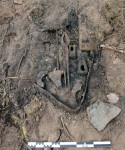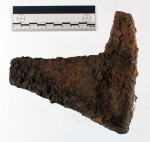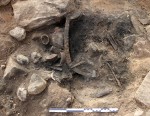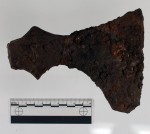 Last fall, farmer Leif Arne Nordheim borrowed his neighbor’s backhoe to remove some pesky flagstones from his garden in Sogndalsdalen on the southwestern coast of Norway. Lifting the last flagstone revealed tools — a hammer and tongs — which Nordheim first assumed were of relatively recent manufacture. When he found a bent blade, he realized it was likely archaeological and called in the county Cultural Department. Archaeologists from the University Museum of Bergen soon followed and an excavation of the find site ensued.
Last fall, farmer Leif Arne Nordheim borrowed his neighbor’s backhoe to remove some pesky flagstones from his garden in Sogndalsdalen on the southwestern coast of Norway. Lifting the last flagstone revealed tools — a hammer and tongs — which Nordheim first assumed were of relatively recent manufacture. When he found a bent blade, he realized it was likely archaeological and called in the county Cultural Department. Archaeologists from the University Museum of Bergen soon followed and an excavation of the find site ensued.
 The find turned out to be far greater than originally realized, and the ancient blacksmith tools were impressive enough already. Archaeologists unearthed a large collection of forging tools and weapons, including three hammers of different sizes, two anvils, blacksmith tongs, coal tongs, a rake to remove coals, a tray used to add coals, a chisel, a scythe, a sickle, a drill, pieces of grindstone, nails, a single-edged sword, an axe, two arrows and a knife. Underneath the tools and products of the blacksmith trade archaeologists found more personal items: a razor, beard trimming scissors, tweezers, a frying pan and a poker.
The find turned out to be far greater than originally realized, and the ancient blacksmith tools were impressive enough already. Archaeologists unearthed a large collection of forging tools and weapons, including three hammers of different sizes, two anvils, blacksmith tongs, coal tongs, a rake to remove coals, a tray used to add coals, a chisel, a scythe, a sickle, a drill, pieces of grindstone, nails, a single-edged sword, an axe, two arrows and a knife. Underneath the tools and products of the blacksmith trade archaeologists found more personal items: a razor, beard trimming scissors, tweezers, a frying pan and a poker.
 The deepest layer of excavation contained ashes, charcoal and small bone fragments. The pieces of bone haven’t been identified yet, but archaeologists believe they are human remains, likely the blacksmith owner of the marvelous tools above. Between the ashes and bones fragments, researchers found the objects that the deceased was probably wearing when his body was cremated: beads and a bone comb.
The deepest layer of excavation contained ashes, charcoal and small bone fragments. The pieces of bone haven’t been identified yet, but archaeologists believe they are human remains, likely the blacksmith owner of the marvelous tools above. Between the ashes and bones fragments, researchers found the objects that the deceased was probably wearing when his body was cremated: beads and a bone comb.
In total the excavation yielded about 60 artifacts and 150 assorted fragments. Forging tools have been found in graves before, but this is an exceptionally rich collection for a blacksmith burial. Indeed, it’s the richest burial, blacksmith or not, found in the area in years.
“We think that the blacksmiths’ contemporaries wished to show how skilful he was in his work by including such an extensive amount of objects. He might have forged many of these tools himself.”
“The grave gives the impression that this was a local blacksmith and he enjoyed a high status in his society beyond being his trade,” says [co-leader the excavation Asle Bruen] Olsen.
 The design of the axe and some of the other metal objects dated them to the 8th or 9th century A.D. Subsequent radiocarbon dating confirmed the date of the burial to be around 800 A.D.
The design of the axe and some of the other metal objects dated them to the 8th or 9th century A.D. Subsequent radiocarbon dating confirmed the date of the burial to be around 800 A.D.
The artifacts are currently being conserved by experts at the University Museum of Bergen. Once they’re stabilized they will go on display, possibly in a dedicated exhibition. Incidentally, the University Museum of Bergen has a neat Instagram account, incidentally. As always, I wish the pictures were bigger, but the highlights from the museum’s collection are fascinating.
Wonderful blog! Many thanks. I imagine a blacksmith would have been one of the most important people in a Viking community.
Absolutely, and you can tell from the wide range of tools and accessories in the grave just how essential they were to everything from personal grooming to farming to war.
I think it’s so interesting that some people were buried with so many of their things, allowing us hundreds (even thousands) of years later to gain a glimpse into their lives; hundreds of years from now, with all the disposable junk we have and the intangible ways we preserve things on the Internet, who knows what will be forgotten and lost?
Have you seen WALL-E? I sometimes think giant piles of disposable crap will be all that’s left of us.
The blacksmith was one of the most important members of society ever since the discovery of metal. Sadly, it took less than one generation to make these craftsmen obsolete.
I’m glad the art of Blacksmithing is making a resurgence these days, even if it’s just people tinkering around in their sheds and backyards.
I like that it’s even conceivable that blacksmithing could be a hobby for someone. It wasn’t too long ago that the notion seemed fantastical. I mean, a home forge? They’re out there now, though.
Smithing is far more than people tinkering around in sheds and backyards (though I am happy that is happening too). There has been a strong resurgence for the last 40 years, with some remarkable work being done, both utilitarian and artistic, and often a combination of the two. Where I live, there are a number of forges making lamps, gates, columns, and other items. Some are widely known. Not a dying trade by any means, as smithing is taught at quite a few schools as a trade and a craft.
That’s great to hear. When I was a kid, I was fascinated by the wrought iron workers at the artisan village of Grazzano Visconti in large part because they seemed so exotic, like the last of a bygone era. Instead they were just keeping the tradition alive and active while everyone else caught up. 🙂
Do you know that the History channel is setting aside some time on its busy schedule of aliens and pawn shops to launch a competition program where blacksmiths make replicas of ancient weapons using traditional and cutting-edge (see what I did there) technology? I know I’m going to be watching. It’s called Forged in Fire and debuts this summer.
:boogie: Truly excellent. I hope that Farmer Nordheim is getting properly included in these efforts (in his possibly rare spare time, since farming is pretty intensive) since he was quite responsible in reporting the find.
Also, the present’s pride in the past is always telling in our interpretations of grave goods. To a point, we always assume that what is interred is stuff that would be needed in the afterlife. But when we find excess, we tend to ascribe it to laud and honor, rather than necessity. It’s not sexy to think that it still might be necessity. But maybe this blacksmith was starting to get forgetful toward the end of his life, despite being excellent at his craft, so his people gave him examples of his work to help him remember once he got to the afterlife. Or maybe he was a great blacksmith, but made a lot of enemies in his life, so these are the things he needs to give as peace offerings or use to attack his enemies. Or maybe he was a cursed smith, so they had to bury everything with him so he wouldn’t be drawn back to life to devour the people who used his final craftings and personal belongings.
..apologies. Am a fan of competing hypotheses. And a bit of a cynic as to how much laud people will voluntarily give to the dead.
No apology necessary, Debbie Downer. :giggle: You’re right, of course, that the large amount of grave goods is not necessarily linked to the esteem in which the deceased was held, but I think the deliberate placement of artifacts suggests a hierarchy of importance. First his cremated body, then his personal items, then his professional items. It seems a more formal thing than “stuff he needs to remember or to bribe/kill enemies in the afterlife.”
Very interesting article!
Glad you liked it. 🙂
Wish we could see the complete weapons but the wooden handle have rotten away sadly.
I bet the metal parts are very fragile as well and it stands to reason the museums to be reluctant to provide a standard continuous exhibition.
Sadly, now all there’s left of vikings (nurtured through popular culture I should add) is Medieval Struggles articles and cute blond chicks wielding swords.
Sometimes I just wish we never developed past the wheel and have our leaders ride a horse in front of the army to battle…
Love the website.
Thought you might enjoy seeing my medieval diorama. While not historically accurate it is fun to look at. You can find it at http://www.historymadesmall.com
Gary
Really interesting. I love seeing the old tools. Thanks for sharing.
You’re very welcome. I wish I could identify them all.
I am absolutely smitten with blacksmithing…it is just so satisfying to take a lump of steel and make a useful or decorative object from it. I wish I had dove into metal smithing years ago, but it is never too late to follow your heart! =D
This is an amazing find. As a practising blacksmith I have many of these tool in my workshop. It just so happens that the 26th April is my birthday.